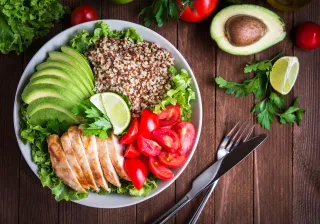The UN estimates that the world’s population will rise to nearly 10 billion in 2050, while the need for food will increase by up to 60% compared to today. Innovation, new technologies and close cooperation between companies are needed to create a more sustainable and efficient food system. In this interview, VTT’s Mirva Lampinen explains how the new Food & Beyond ecosystem addresses the challenges.
There are many factors behind the revolution of the food industry: one of the biggest is climate change, which is shaping the entire global food system.
– The amount of cultivated land is decreasing globally, but the number of people needing food is increasing at the same time. Food production needs to be managed in a much more resource-efficient way, and the need for change will inevitably also affect Finland, VTT’s Co-Creation Manager Mirva Lampinen says.
Food production needs to be managed in a much more resource-efficient way, and the need for change will inevitably also affect Finland, says Mirva Lampinen.
According to Lampinen, the eating habits of consumers have also changed. The changes in consumer behaviour have taken place even faster than initially anticipated.
– In practice, these changes are reflected, among other things, in food shopping being increasingly done online, increased demand for convenience food, increasing prevalence of eating out in restaurants and, on the other hand, in people being more and more used to ordering portions through various food delivery companies, such as Foodora or Wolt.

Smart food solutions for the world
Lampinen, who has a long history in the food industry, has been brainstorming VTT’s new Food & Beyond ecosystem for the past year and a half. The operations of the ecosystem will be diverse, including networking, various projects and training.
– The ecosystem aims to help the domestic food industry meet the challenges of the future by creating the expertise and new opportunities it needs to succeed in international competition as well, Lampinen says.
Finnish food exports to the world totalled EUR 1.6 billion in 2018, mostly exported to the EU area. The goal of the Food from Finland export programme of the food industry is to double Finland’s food exports by 2023. According to Lampinen, this requires, among other things, raising the degree of processing of food exports to a higher level than at present.
– The export products of our food industry should not be just raw materials, as is mostly the case today, but technologies, highly processed products and smart food solutions, she emphasises.
Lampinen points out that already today, for example, Finnish oat and vegetable protein expertise is top-notch, and these products are also exported to the world. The ecosystem aims to find more success factors for Finland while also looking for new answers to global food production challenges.
– I would like to see Finland as a leader in the international food industry in 10 years’ time and for us to be able to produce smart solutions that will help solve global problems in the food industry. However, no company can do this alone – a larger group of operators from different industries is needed. VTT wants to act as an enabler for the necessary cooperation between companies.
Answers to questions about the future
Along with food production, the food system refers to the entity made up from transport, storage, processing, trade, preparation, consumption and waste management. According to Lampinen, the ecosystem will be built in a needs-based manner. Using the workshop method, VTT has already explored the kind of support and cooperation companies in the industry need in their search for the keys to success.
– At our workshops, a wish came up for us to be able to consider together what the future will really bring to the industry – what scenarios await operators in the industry and what technologies the industry needs to succeed, for example. In our first year of operation, we will start addressing these questions by organising a series of future-oriented training workshops for companies.
Lampinen adds that VTT wants to provide services that are of interest to companies through the ecosystem.
– Last year, we started building the EIT FAN (Food Accelerator Network) startup incubator together with the European Institute of Innovation and Technology (EIT) which will open in summer 2020. Ten startup companies will be involved in the incubator.
According to Lampinen, it is important for companies to follow what is happening in the field of startups, as the “first signals” and future trends of different industries very often start out through agile startups.
– It has been seen both in Finland and abroad that the most interesting startups cooperate with large companies. This cooperation can lead to fundamental technological shifts that change the way the industry works, sometimes even radically.
– The food system is a vast field that can include ideas from food products to cutting-edge agricultural technology.
Need for protein is increasing
Plant alternatives to animal protein are being sought at an accelerating rate, but animal production is still needed.
– Eating meat will not disappear from the world in ten years, but I would hope that, at that point, meat would be produced only in countries where it makes sense in terms of environmental sustainability, Lampinen says.
She emphasises that when thinking about the future of Finnish food production, we should always consider both the global and the national scale at the same time – that is, how we can maintain the vitality of Finland’s countryside so that we would be self-sufficient enough in terms of food production even in the event of a crisis.
– From the point of view of biodiversity, it is not sensible to give up beef production in Finland, but we must develop our production methods to be more environmentally friendly. At the same time, we should consider whether we can further increase the cultivation of domestic protein sources, such as broad beans and peas.
New high-tech solutions are also needed to increase food production and keep the population of Finland and the whole world fed. For example, cell cultivation can already be used to produce edible protein – so-called lab meat. However, according to Lampinen, new production technologies do not mean that traditional food production will disappear. They only add to it as the world’s population grows, and therefore also the need for food production.
Text: Nina Garlo-Melkas
Photo: Timo Porthan and Shutterstock





